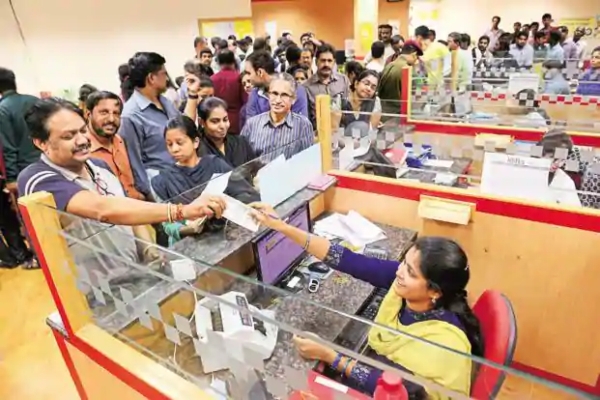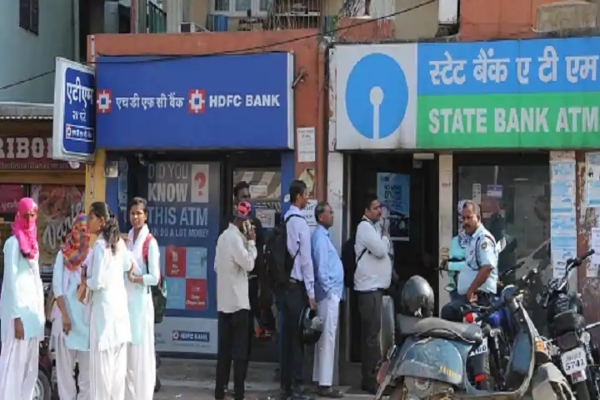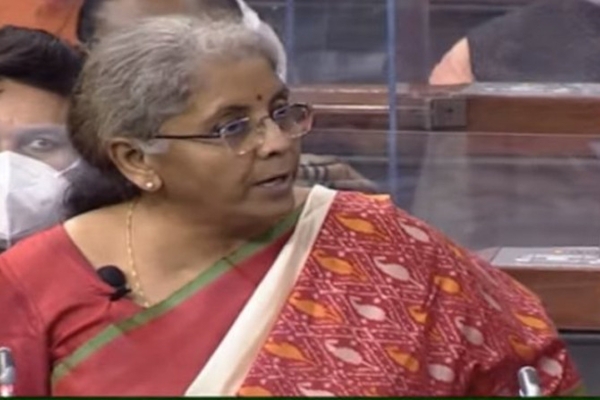BUDGET 2021 : Roadmap for Banking
Total Views |
The Union Budget 2021 is the first budget of Independent India drawing a roadmap for 5 trillion dollar economy to prepare India to establish its leadership as a global superpower. There are temptations to compare it 1991 Budget when our country first tried to free from Quota Permit Raj and started dismantling the shackles of Socialistic Model. But it should be appreciated that 1991 was a tipping point of disaster failure of economic model our country after independence. However this budget is an unique and historic Budget in many aspects as it does not shy away from increasing the capital outlay and providing a fiscal push to lift the morale of an economy which is reeling under the shock of a once-in-a-150-year-event of Covid 19 and to achieve the dream of making India a superpower. Let us breakdown certain numbers to illustrate the point.
In 2021-22, capital expenditure is estimated at Rs 5,54,236 crore (annual increase of 29% over 2019-20). Revenue expenditure is estimated to be Rs 29,29,000 crore (annual increase of 12% over 2019-20). In 2020-21, total expenditure was 13% higher than the budget estimate, with revenue expenditure increasing by 15% and capital expenditure by 7%. In 2019-20, capital outlay formed 12% of the total expenditure of the central government. This is estimated to increase to 15% of the total expenditure in 2021-22. In 2021-22, disinvestment is estimated at Rs 1,75,000 crore which is 3.5 times higher than the actual disinvestment in 2019-20. The highest disinvestment achieved over the last few years was in 2017-18, of Rs 1,00,045 crore.

These numbers certainly give a jitter and raise the question as to whether our financial system is really capable of handling these gigantic numbers because in absence of a robust financial system it becomes very challenging for any economy to handle such huge out lay. Our financial system primarily consists of Banking, Non Banking Finance Companies, Mutual Funds, Insurance Companies and Stock Markets. In order to achieve the ambitious targets this budget has a very bold and well defined road map for these sectors.
Current Status of Banking Sector: In order to understand the strength of Banks, primarily two ratios are considered. The first one is Capital to risk-weighted asset ratio (CRAR) and the second is their Gross Non-Performing Advances (GNPA) ratio. The CRAR decides as to how much bank can lend. As of 2020, under Basel III, a bank's tier 1 and tier 2 minimum capital adequacy ratio (including the capital conservation buffer) must be at least 10.5% of its risk-weighted assets RWA). That combines the total capital requirement of 8% with the 2.5% capital conservation buffer.
The capital conservation buffer recommendation is designed to build up banks' capital, which they could use in periods of stress. Inversely if any bank wants to lend Rs.100.00 then it must have minimum own capital of Rs.10.50. Capital to risk-weighted asset ratio (CRAR) of Scheduled Commercial Banks increased from 14.7 per cent to 15.8 per cent between March 2020 and September 2020 on account of improvement of CRAR of both Public and Private sector banks.
Gross Non-Performing Advances (GNPA) ratio denotes the percentage of advances (loans) of a bank which have become NPA. Once the loan becomes NPA bank cannot book interest on that amount (even though right to recover remains intact) and bank has to provide from interest earned on performing advances, reducing the profitability of bank. At present Indian Banking sector is reeling under the pressure of Non Performing Assets due to reckless lending during last decade. However as a result of continuous ongoing efforts of government by strengthening recovery mechanisms, Gross Non-Performing Advances (GNPA) ratio (i.e. GNPAs as a percentage of Gross Advances) of Scheduled Commercial Banks decreased from 8.2% at the end-March 2020 to 7.5 % at end-September 2020. GNPA ratio of Public Sector Banks (PSBs) decreased from 10.25 per cent at the end March 2020 to 9.4 per cent at end-September 2020. Considering that the focus on resolution of stressed assets had to take a backseat during the year on account of the outbreak of the Covid-19 pandemic, this achievement is really praiseworthy.

The process of strengthening the Indian Banking has begun since last couple of years. The major initiatives taken can be summarised as under-
a. Merger of PSBs: Consolidation among another 10 PSBs, with Punjab National Bank, Canara Bank, Union Bank of India and Indian Bank as anchor banks came into effect from April 1, 2020.
b. Large exposure framework: A bank’s exposure under the Large Exposure Framework to a group of connected counterparties was increased from 25 per cent to 30 per cent of the eligible capital base of the bank. The increased limit will be applicable up to June 30, 2021.
c. Export Credit: The maximum permissible period of pre-shipment and post-shipment export credit sanctioned by banks was increased from one year to 15 months for disbursements made up to July 31, 2020, in line with the relaxation granted in the period of realization and repatriation of the export proceeds to India.
Urban Cooperative Banks (UCBs)
d. Revision in the target for priority sector lending: To promote financial inclusion, the overall priority sector lending target for Urban Co-operative Banks has been increased from the present level of 40 per cent of adjusted net bank credit (ANBC) by March 31, 2024.
e. All co-operative banks have been advised of their inclusion as Eligible Lending Institutions under the “Interest Subvention Scheme (ISS) for MSMSEs 2018” of the Government. This scheme provides an interest relief of two per cent per annum to eligible MSMEs on their outstanding fresh/incremental term loan/working capital during the period of its validity.
f. Reporting of large exposures to Central Repository of Information on Large Credits (CRILC): Urban Cooperative Banks (UCBs) with assets of Rs.500 crore and above were brought under the CRILC reporting framework. Accordingly, UCBs shall report credit information, including classification of an account as Special Mention Account (SMA), on all borrowers having aggregate exposures of Rs.5 crore and above with them to CRILC.
g. Limits on exposure to single and group borrowers and large exposures: The exposure norms for single borrower and a group of borrowers from 15% and 40% of UCB’s capital funds, to 15% and 25% respectively, of UCB’s Tier-I capital. The revised exposure limits shall apply to all types of fresh exposures taken by UCBs, and they shall bring down their existing exposures which are in excess of the revised limits to within the aforesaid revised limits by March 31, 2023. Further UCBs shall have at least 50 per cent of their aggregate loans and advances comprising loans of not more than Rs. 25 lakh or 0.2% of their tier I capital, whichever is higher, subject to a maximum of Rs.1 crore, per borrower.
h. Amendments to the Banking Regulation Act, 1949: Banking Regulation (Amendment) Act, 2020: The Banking Regulation Act has been amended by the Banking Regulation (Amendment) Act, 2020. The key changes in the regulatory regime of UCBs pursuant to the Banking Regulation (Amendment) Act, 2020. The salient features of the amendments are 1) RBI has been given powers over the management of the UCBs, owing to which it can issue directions relating to the management of UCBs. 2) RBI has been empowered to supersede the Board of Directors of a UCB 3) RBI has been empowered to sanction voluntary/compulsory amalgamation and to prepare scheme for reconstruction of a UCBs.

The salient features of Budget 2021 drawing a roadmap for strengthening Banks to support the dream of Atmanirbhar Bharat can be summarised as under-
Recapitalization of Public Sector Banks (PSBs)
To further consolidate the financial capacity of PSBs, further recapitalization of Rs.20,000 crores is proposed in 2021-22. Rs. 6990 Crores, 25,000 Crores, 25,000 Crores, 88,139 Crores, 1,06,000 Crores and Rs. 70,000 crores were provided for recapitalization of PSBs during Financial Year 2015,2016,2017,2018,2019 and 2020 respectively. Thus Rs. 3.21 Lakhs Crores have been infused into PSBs upto FY2020-21. It will be interesting to recall that the Industrial Policy Resolution of 1991 has identified strategic areas and non-strategic areas for the public sector. The government decided to concentrate only on the strategic sector by withdrawing the public sector from most of the non-strategic sectors. Adding efficiency and infusing competitive business practices became the main solution to control the losses of the PSBs, 10 PSBs were consolidated into 4 Mega Banks. This illustrates the resolve of NDA government to strengthen PSBs. As on date there are 12 PSBs. The shareholding of Government in these PSBs ranges from highest of 93.29% in UCO Bank to lowest of 61% in SBI. The budget has proposed privatization of two PSBs other than IDBI Bank.
Stressed Asset Resolution by setting up a New Structure (Bad Banks)
The high level of provisioning by public sector banks of their stressed assets (NPAs) calls for measures to clean up the bank books. This budget propose to form an Asset Reconstruction Company Limited and Asset Management Company to consolidate and take over the existing stressed debt and then manage and dispose of the assets to Alternate Investment Funds and other potential investors for eventual value realization. This will ease the burden of huge chunk of NPAs and banks will get a reprieve to lend more.
Challenges of Governance of PSBs
There seems to be consensus that NPA problems of PSBs are much bigger than what was initially thought. The Government is finding it difficult to recapitalise them to comply with Basel norms because of lack of resources in its kitty. There is always a limitation to divert taxpayers’ money for this purpose as we have a very low tax paying population. But it is also true that no government can afford to leave PSBs to their own destiny because of democratic political compulsions as they act as the “Delivery Boys” for most of their social welfare programs. The mergers of PSBs may solve the issue temporarily but there is no surety that the problem may not recur again unless the basic issue of governance is addressed. The NPA and other issues are symptoms of the problems but the real issue lies in the governance of these PSBs which requires urgent attention of government.
PSBs are facing lot of challenges today. However mounting and ever rising NPAs have threatened their very existence. The economic recession during last decade is attributed to this situation but political patronage to large defaulters, not so stringent recovery infrastructure and dilution of prescribed norms while sanctioning these loans had played a major role in worsening the situation. It is bitter truth that more than seventy percent of present NPAs (by amount) are from large corporate whose most of the loans are sanctioned at top management level or at board level and the appointment to boards are directly made or with the concurrence of the Government of the day.

It will be injustice on present government to say that nothing has been done to rectify the situation but it must be humbly stated that the more effective measures should have been taken considering the deep rooted problem. It may be recalled that The PJ Nayak Committee was formed in May 2014 to Review Governance of Boards of Banks in India which suggested to form an independent “Banks Board Bureau (BBB)” Accordingly on 28th February 2016, the Government formed “The Banks Board Bureau”(BBB) which started functioning from 1st April 2016 as an autonomous recommendatory body to help prepare the PSBs to take on the competition, have the ability to appropriately manage and price risk across business cycles, develop resilience to generate internal capital and have the capacity to generate external capital warding off the moral hazard in counting on the scarce budgetary resources of tax payers.
The Bureau is also entrusted with the PSBs to help build capacity to attract, retain and nurture both talent and technology. The Bureau is also entrusted to have a fully empowered board in each and every PSB. However very little has been achieved as the performance of the BBB in this regard could not fulfil the expectations of the stakeholders. Even appointments of chairpersons of PSBs have to go through the Appointments Committee of the Cabinet through the Bureaucracy. There is still ample scope to improve the appointment process not only at the board level but down the line also.
The author of this article has great respect for talent and administrative skills of Indian Bureaucracy but it will not be out of place to draw attention to the observations of The P.J.Nayak Committee when it suggested that “Government officers and regulators may not possess the skills to appoint the top management of commercial banks. Banking is a very specialised activity and the management needs to combine strategic foresight with a good commercial knowledge of sectors to lend to, prudent risk management and human resources skills.” It’s high time government initiates bold reforms by professionalising banks so that Banking Sector in general and PSBs in particular play an effective role to achieve the dream of 5 trillion dollar economy.
.
.
